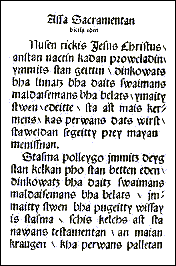| Group | Baltic (with Latvian, Lithuanian etc.), West Baltic (with Sudovian, Galindan, Curonian etc.) |
| Geography | Was spoken in Prussia, today's south-western Lithuania, northern Poland and the Kaliningrad region of Russia. |
| History | Old Prussian was westernmost of all Baltic tongues, this is why it
was subject to constant invasions from the West. To convert Prussians into
Christianity, Poles and Teutons conquered the land in the 13th century.
The language was suppressed by German and Polish. Only during the Reformation
several short texts were written in Old Prussian - two Catechisms and the
Enchridion (from 1545 to 1561). A few small dictionaries were composed
in the 17th century, but by the end of the century the language was no
longer spoken, it became extinct.
Today people of Germany, Poland, Lithuania and the USA work on reviving the language - communities are established where people learn Old Prussian history, culture and language itself. |
| Phonetics | Because of the lack of reliable materials, the phonetic system of Old Prussian is still arguable. It is doubtless that different dialects showed varieties of the language: the First Catechismus seems to present much less diphthongs than the Second one; in the Second Catechism, a becomes e in many positions. As a whole, Old Prussian phonetics shows definite Baltic features (like o, > a, ), and even quite archaic ones. |
| Nominal Morphology | It seems that the noun in Old Prussian used four or five cases. Some linguists explain this as a process of analitization; but some say that Baltic never had more, though modern Lithuanian and Latvian had up to seven ones. There were 3 genders and two numbers. As far as we can judge from the texts, pronominal forms of adjectives were in use, the same as in Lithuanian (pirmas - pirmois 'first'). The Catechisms use the definite article, and it is still a question whether the article was Old Prussian by nature or was introduced by a German-speaking translator. |
| Verbal Morphology | There was obviously two tenses in Old Prussian: the present and the past, and up to four moods (optative, imperative and subjunctive forms are witnessed). The verb was highly inflective, though - as in all other Baltic tongues - the third person did not vary in number. Catechisms present a lot of analytic forms (like the future constructions with wirst 'becomes' + participle). Old Prussian combines archaic and innovative features in its morphology. |
| Lexicon | A lot of isoglosses unify Old Prussian with Slavic, and sometimes this is just evident; other common terms are mainly Old Prussian borrowings from Slavic. Old Prussian also contained numerous loanwords from Germanic (Gothic). The language is important for its archaisms no longer heard in any other Baltic dialects. |
| Writing | Latin alphabet |
| Close Contacts | Close to other West Baltic tongues, like Sudovian, Galindan and Curonian; also contacted closely with Slavic (in prehistoric times), with German (since the 13th century). |
| Picture |  |
| More info |